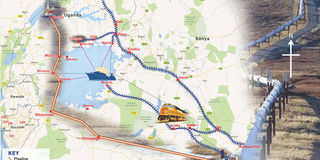Tanga pipeline to take more than just oil to sea

What you need to know:
Benefits. With Uganda choosing to export oil through the port, Daily Monitor explores the many advantages Tanga offers to Uganda
Kampala.
Officials from Uganda and Tanzania will in the coming days meet to fine-tune the work plan for the development of the proposed Shs11 trillion crude oil export pipeline.
The 1,400km pipeline will run from Hoima District in the Albertine Graben through Masaka and Mutukula in Uganda to Bukoba, Biharamulo, Shinyanga, and finally to the Indian Ocean port of Tanga in Tanzania.
For Tanga – the oldest port in East Africa having been established by Portuguese traders around 1500 as a trading port for ivory and slaves – the development will likely rouse the city port that had faded off the region’s trading map following the rise of Mombasa (further north) and Dar es Salaam (further south).
Tanga remains Tanzania’s second largest port though, handling about 700,000 tons of cargo annually, according to the Tanzanian Ports Authority (TPA). It handles a negligible amount of cargo – if at all – to and from Uganda.
While recent discussions and developments have majorly revolved around the pipeline, for Uganda, a landlocked country, the development could finally open up an alternative and perhaps a more reliable route to the sea.
Currently, Uganda heavily relies on the Indian coastal port of Mombasa in Kenya for more than 90 per cent of its in-bound and out-bound cargo, nearly all of it by road. The port is congested and it takes up to four days to clear goods out of the port. The construction of a new standard gauge railway along the old 1892 Uganda railway route from Mombasa through Nairobi, Kisumu to Tororo and Kampala, once completed, might shift some cargo onto the rails but experts have repeatedly warned that it is risky business to rely on one access to the sea.
So what opportunity in real terms does Tanga present to Uganda and Tanzania?
Old plan, new need
In the 1960s, then Tanzanian president Julius Nyerere and his Ugandan counterpart Milton Obote (both socialists by political orientation) mooted the idea of Uganda leasing the port of Tanga from Tanzania so it becomes Uganda’s point of access to the sea as an alternative to Mombasa.
Tanga had been eclipsed by the growth of Dar es Salaam and with the sisal export trade, the mainstay of the port dwindling, Tanzania wanted to create a new use for the port that would bring in revenue and stimulate the city.
The plan, however, died at its infancy with the overthrow of Obote in 1971 and the ascendency to power of Idi Amin. After Amin was overthrown in 1979, the idea remained an on-and-off talking point which never crystalised into concrete action.
Instead much attention was focused on the use of the “southern route” as an alternative import/export avenue for Uganda. The southern routes follows Tanzania’s central railway which runs from Dar es Salaam port through Dodoma to Tabora and finally to Mwanza port on the southern shores of Lake Victoria. From Mwanza, wagons were then loaded onto ferries docking at Jinja or Port Bell on the northern shores of Lake Victoria.
To complete the railway-ferry route, Uganda in 1983 commissioned three large capacity wagon ferries to ply the lake from Mwanza (in Tanzania) to Jinja and Port Bell. They were MV Pamba, MV Kaawa and MV Kabalega each with capacity to carry 44 20-foot containers mounted on 22 40-foot railway wagons.
The route had previously been plied by only two smaller wagon ferries – MV Uhuru and MV Umoja – that belonged to the defunct East African Community. Idi Amin’s government then ordered and fully paid for three larger ferries from Belgium whose construction was, however, completed four years after his ouster.
The southern route was active for many years until 2005 when all Uganda’s marine vessels were grounded following the sinking of MV Kabalega after it collided with MV Kaawa. Today, there are almost no imports or exports that go through this Mwanza route.
Making Tanga route reality?
The prospect of Tanga becoming Uganda’s main import/export route has been revived by the oil pipeline. Tanga offers many advantages to Uganda. It is not congested and will likely remain so for the foreseeable future as Tanzania has two other major ports – Dar es Salaam and Mtwara further south. Mtwara serves mostly landlocked Malawi and Zambia.
Uganda would, therefore, have nearly exclusive use of the port, which would also benefit countries further inland, especially Rwanda and South Sudan.
In terms of distance on the ground, Tanga and Mombasa is more or less the same distance to Kampala. It is 945km from Tanga to Musoma on Lake Victoria and 161 nautical miles (approx. 300km) across the lake from Musoma to Port Bell or Jinja. That translates into a total of 1,245km from Tanga to Port Bell, Kampala.
Mombasa to Kampala on the other hand is a distance of 1,165km by road, a difference of about 100km. What makes Tanga route more attractive, though, is that it would hinge on the cheapest forms and environmentally friendly means of transport in the world – railway and water.
Unfortunately, currently there is no wagon ferry plying the routes. Marine operations were concessioned to Rift Valley Railways while the Uganda Railways Corporation retains the supervisory role.
So to make Tanga a reality, both Uganda and Tanzania would have to make serious investment in revamping or developing infrastructure around the route, starting with the railway.
Currently, there is a narrow gauge railway that runs from Tanga port to Moshi with a branch to the Mombasa-Kampala line at Voi in the Taveta hills, Kenya. The line would have to be upgraded to a standard gauge railway and extended to Arusha and Musoma on the shores of Lake Victoria from where vessels can ship containers to Port Bell/Bukasa, Bukakata and Majanji in Uganda.
Uganda-bound cargo would be discharged at Port Bell and Jinja while South Sudan bound cargo would be discharged at Majanji port in eastern Uganda from where a 52km railway link would connect it to Tororo and then transported on to Pakwach of Gulu, then by road through Nimule or Oraba border points. Rwanda bound cargo would be discharged at Bukakata and transported by road via Masaka, Mbarara and Katuna or Mirama Hills.
To make this a reality, the country needs to invest in large water vessels that can carry containers as wells as open cargo-like vehicle carriers on Lake Victoria beyond the two grounded ones – MV Pamba and MV Kaawa. New ports would also have to be built at Bukakata and Majanji and old ones at Jinja and Port Bell revamped to handle bigger volumes of cargo. In addition, marine safety measures – currently wanting – would also have to be created.
Is govt working towards making the Tanga route a reality?

Dilapidated ferries that previously plied the Mwanza- Jinja- Port Bell route docked at Port Bell, Luzira, recently. FILE PHOTO
Mr Dicksons Kateshumbwa, the commissioner for Customs with the Uganda Revenue Authority (URA), told Daily Monitor that in 2013, URA and the ministry of Trade explored the option to have Tanga added as an option for Single Customs Territory (SCT) implementation if and when Tanzania came on board.
SCT is a seamless clearance of goods achieved by the removal of restrictive regulations and reducing internal border controls on goods moving that was recently adopted by the EAC heads of states.
Tanzania did come on board at the start of 2014.
However, the assessment found Tanga port to be inefficient to work as an option for Ugandan destined cargo. One issue was that were challenges of transporting cargo through Tanzania because of the “ineffective inland transport system.”
All cargo, including fuel, had to be transported by road. Additionally, it was also noted that Tanga lacked the capacity to handle bigger ships and, therefore. “requires dredging and installation of equipment to handle bigger ships,” the assessment reads.
“True, going through Tanga Port would be advantageous because it provides a shorter link to the port of Mwanza on Lake Victoria to connect to Port Bell and Jinja pier if the lake transport is improved. It also provides a shorter link to south-western Uganda through Mutukula and Kikagati entry border posts,” says Mr Kateshumbwa.
According to the ministry of Trade, part of the trade facilitation improvements to link Uganda to alternative routes will be the completion of the Bukasa Port. Government recently moved to borrow Shs596b from China for the development of the port.
An official within the ministry, however, pointed out that the efficient utilisation of the inland ports in Uganda would depend on infrastructure improvements in Tanzania such as a railway and expansion of the Tanga Port.
A senior transport officer in the ministry of Works, Mr Henry Ategeka, said in 2009 the leaders of Uganda and Tanzania signed an MoU to revamp the existing railway network and to develop the ports on Lake Victoria, which requires massive financing.
Works ministry officials admitted that while Tanzania is currently “doing serious work on their side,” Uganda is not doing enough.”
A joint team from both countries has been established and are currently manning the Southern Corridor secretariat based in Tanzania.
“In the next 2-3 months we should be having a draft document that Cabinet should be looking at. After this, we should be ready to move,” said Mr Ategeka.
Many Ugandan importers and exporters will be waiting with bated breath in the hope that the pipeline might just be that opportunity the country was waiting for to have another cheap alternative access to the sea.




